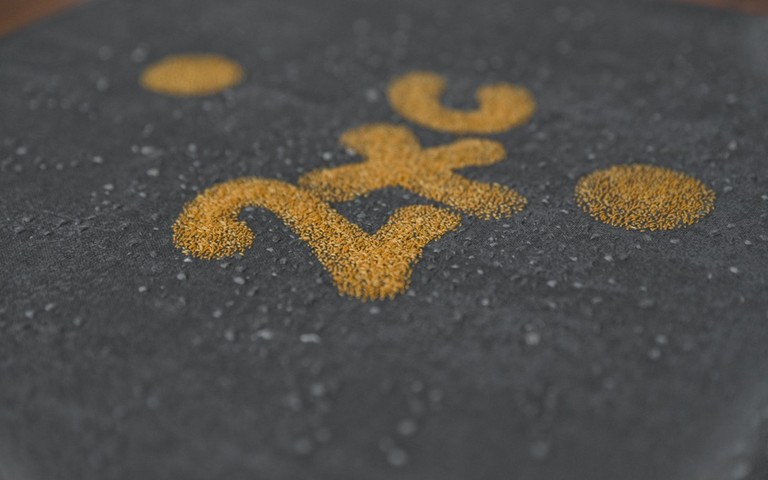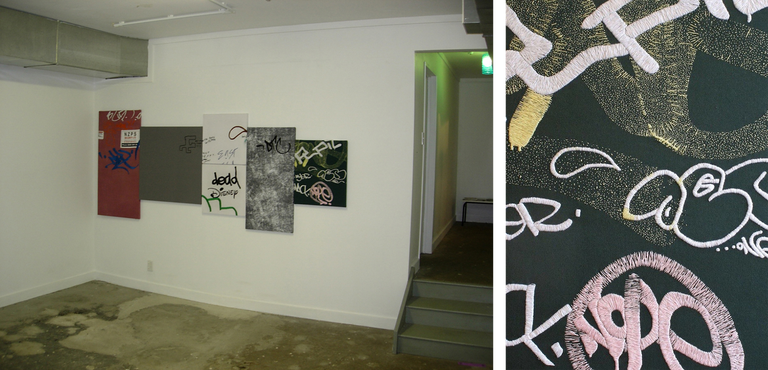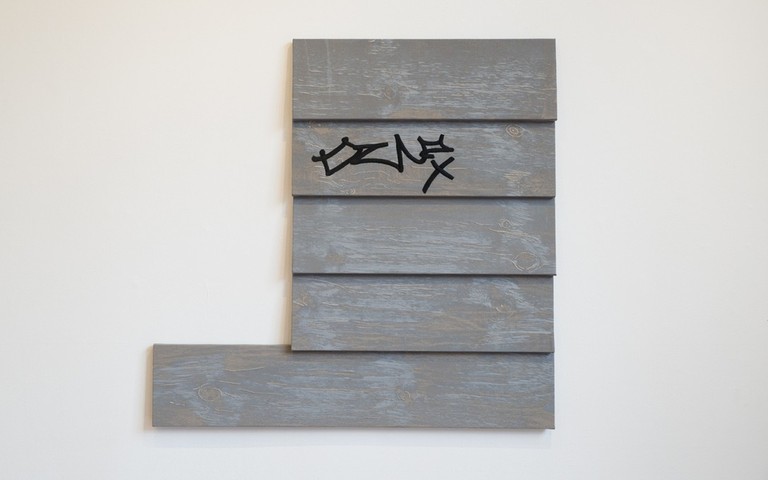The Occasional Journal
Local Knowledge
July 2016
-
Editorial
Emma Ng -
Diversifying and moving through the hidden city
Gradon Diprose, Kelly Dombroski -
Don't fucking die today! Putain, ne meurt pas aujourd'hui!
Janet Lilo -
Stitching the Street
Sian van Dyk -
In your belly, a vague place
Ngahuia Harrison -
The Fair in May
Laila O'Brien -
No Stone Unturned
Aliyah Winter, Angela Kilford -
Kinetic Rituals
Balamohan Shingade -
At the still point
Elisabeth Pointon
Stitching the Street
Sian van Dyk

Jay Hutchinson, turn left at the end of the drive. Enjoy Public Art Gallery, 2016. Image courtesy of Shaun Matthews.
“Do you live in Newtown?” she demanded.
“No, sorry; Mount Victoria,” I offered.
My sense of belonging was thrown when, arriving at the local school market to buy my weekly vegetables, I was approached by a determined Ginette McDonald—a.k.a. Lynn of Tawa—in her local body election campaign. Camera crew on hand, she had exchanged her comedic persona to audition for the role of Southern Ward councillor, and ultimately, create a better environment for the people of Newtown.1
“Right.” Rolling her eyes, she paraded off to find her next potential supporter.
I felt a pang of guilt. While I don’t live there, I have come to form a bond with my neighbouring suburb, often describing my little flat as being “on the dodgy end of Mt. Vic., practically in Newtown”. It made me wonder: what draws one to a place?
Walking down Riddiford Street I am often struck by the impermanent appearance of faux Wild West facades and late Victorian buildings. Built as if to make do for now, they have yet to crumble after over a century. They are relics of the demand for more infrastructure in a southern tract of land, earmarked for a growth spurt in the late 1870s.2 In 1998, the principal of Newtown School, Laures Park, described how the scene of my veggie market forays had grown to reflect the multicultural centre this inner city suburb had become:
Newtown School was opened in 1879 and according to the records can still be used as a barometer for the immigration policies of the country or as a gauge of the ‘trouble spots’ around the world. The coup in Fiji, the break-up of the Soviet Union, the fighting in Vietnam, Somalia, Bosnia and Iraq and even the consequences of the Asian economic situation have all presented Newtown with a kaleidoscope of colours, cultures and languages though the children, their care givers and extended whanau.3
Moving to a new city doesn’t feel right until you find the places you connect with, filled with people who think, act, and look like you. In their paper The Psychogeography of Creativity, Richard Florida and Charlotta Mellander recall an article in The Economist, “The World Goes to Town”, where the term “Homo Urbanus” is used to emphasise how cities have come to influence us. Florida and Mellander bring together a wide range of psychological studies that consider the kinds of people drawn to cities, and how they contribute to pockets of urban centres being vibrant, economic hubs. Important to this mix are the “creative class”; university graduates, artists, bohemians, and immigrants, who are likely to be open minded and bring new ways of thinking and doing. The authors introduce the notion “geography of personality”, maintaining that most of us place higher importance on look and feel, and whether we can make connections with others, than we do on public services and amenities.4
These studies—being both American, and unable to show the grime of city life—are limited. However, they do evoke the global inner city suburb manifested in Wellington as Newtown. This suburb continues to be inclusive, recently welcoming one of the largest groups of Syrian refugees in the country.5 Newtown’s community consists of working class families, beggars, students, artists, and liberal professionals, who increasingly live in rental properties too expensive for most of them to own. Anyone wandering Newtown’s shopping district for the first time will discover a library, op shops, and bargain discount stores, neighboured by family businesses. A string of unpretentious restaurants that permeate the street with the aromas of international fare have settled for good, while dub beats at Baobab meet grunge from Black Coffee down the road. This place is a cacophony of influences that exudes an essence of urban twenty-first century Aotearoa. Not wealthy, but making do, it retains a charm that those with money to spare often sweep away. With its unpolished surface bearing a healthy patina, Newtown doesn’t feel the need to put up pretences.
***
When Dunedin based artist Jay Hutchinson moved to Wellington in 2012, he chose to settle in Newtown because he saw it as:
…a melting pot of ethnic groups from a wide range of social and political backgrounds. It had a charged environment; the kind that has inspired my way of life and subsequently, my art making.6
Over the last ten years, Hutchinson has developed an art practice based on his identification with graffiti subculture. Growing up in an air force family, he moved approximately twenty times up until the age of sixteen. He reacted to his transient childhood by vandalising other people’s property. What he described as “painting” became an act of self-determination: a way to stake a claim.7 Through it, he discovered a community that spoke a universal language found on street corners.
While completing his Master of Fine Arts, Hutchinson began to explore the politics and perceptions of this subculture. An experienced tagger, he was interested in the unwritten laws that determined who could tag where, and when it was acceptable to write over others’ work. He translated the designs and texts that resulted from these rules—illegal marks, ugly to the untrained eye—into delicate embroideries. In his breakthrough exhibition From Concrete to Textile (Blue Oyster Art Project Space, 2006), Hutchinson explored the theories of Walter Benjamin and asked his audience to consider how and when copies become originals. He presented six embroidered, stretched canvases that were manipulated and stained to resemble street textures such as stone, wood and concrete.8 The harsh, tagged lines were recreated with luminous cotton and lifted out of their natural habitat onto clean, white gallery walls. Positioned outside of the marks’ usual context, these pieces became an investigation of formal qualities, appreciated for the skill associated with embroidery.

Jay Hutchinson, From Concrete to Textile. Blue Oyster Art Project Space, 2006. Images courtesy of the artist.
However, graffiti and embroidery sit at opposite ends of the visual arts spectrum and each has deeply embedded connotations. The latter is associated with the feminine, measured and private while the former more so with the masculine, hasty and public. Both are connected with marginalised groups: exploited women in third world countries, and hooded young men trying to find a voice in urban environments. What began as a visual deconstruction of the politics of street art became perceived as a comment on gender stereotypes. Hutchinson reacted to this reading with a series of performances carried out between 2007 and 2015 where he replicated sweat shop conditions, making t-shirts for ten cents an hour. In doing so, his work took on new political intent gleaned from Marxist theory, exploring how time and labour are valued in a society driven by capitalism.9 Over this period he continued to make embroidery based works with an autographical bent. One of these, Loosely Based on a Series of Events that Never Actually Happened (A Gallery, Dunedin, 2012), recounted his teenage years through embroidered doodles on classic Warwick notebooks and crumpled paper. Reproduced in silk, these sat inside an old wooden school desk emblazoned with inflammatory text and drawings by bored high schoolers. This installation was an important step for Hutchinson, who began to explore how the context of presentation could encourage viewers’ to consider his embroidery practice as something other than a comment on gender stereotypes.

Jay Hutchinson, Loosely Based on a Series of Events that Never Actually Happened. A Gallery, 2012. Images courtesy of Justin Spiers.
Before I was allowed to see the work being prepared for turn left at the end of the drive (Enjoy Public Art Gallery, Wellington, 2016), Hutchinson led me back out his front door and down his long driveway to the street. Along the way he asked me to take note of a corrugated fence, two slabs of concrete on the footpath, the facade of an old panel beater shop next door and a black electrical cable box. Two of these scenes were covered in tell-tale paint patches and two were spray painted with marks made by infrastructure contractors. Like points on a map charting contested land, each signified a claim. “Graffiti is generally removed monthly by a group of volunteers in a council led initiative to keep Newtown beautiful”, he informs me. One could argue the contractors’ commissioned marks—prevalent all over the city once you think to look—are equally invasive, yet remain untampered with.
In 2008, members of the Wellington Architectural Centre challenged the clamp down on graffiti, arguing that it contributes to city life and our brand as the “creative capital”. Christine McCarthy, the Centre’s president and senior lecturer at Victoria University School of Architecture, stated: “It makes viewers think or see the world differently... it is not something that can be controlled.”10 In response, the Council’s graffiti team head Graeme Bakker noted the difference between “graffiti art” and “tagging”:
One can be quite remarkable at times, the other is pure vandalism. So long as it’s done with permission, intelligence and respect, then there’s no problem. The key thing is permission… Tagging is basically about leaving a mark. It’s about saying, “I have an identity”. The city [wants] to educate taggers and provide outlets for their creativity, rather than [beat] them within an inch of their lives.11
The cyclic removal and application of graffiti is a silent battle, highlighting a dissonance between the growing privatisation of space and the human need to feel a sense of control and belonging in the places we live.12 I ask Hutchinson how he settled on recording this area. He reflected that his time practising graffiti had taught him to observe and consider the urban environment more closely. He described how the architectural features of the city became a guide for his compositions:
We would walk the streets, always looking up high towards rooftops and down low in alleyways: noticing parts of a city that are usually ignored. The more you look at your immediate environment the more free compositions you find. My driveway and its surroundings are transient spaces that I pass through daily. By nature I always take note of graffiti, but I started to notice all the markings indicating gas and electricity lines too. Like graffiti, they communicate a hidden language that no one generally notices or understands.13
The final five pieces in turn left at the end of the drive, installed after hundreds of hours of embroidery show a distinct visual and thematic shift in Hutchinson’s practice. Combining embroidery and sculpture he presents his work within a new context: exploring peoples’ relationship with the urban landscape. The gaudy pink tag by “GNIK” and black scrawl of “DZNE” composed on neighbouring buildings, the white marker labelling the electrical cable box “PORKER FKBS”, and the official faded orange line and brighter “2XC” left behind on the sidewalk are all recreated to scale. Unstretched canvas is treated with starch to appear like corrugated iron. Stretched canvases lie on the floor like segments of concrete and tar. One group is built together to simulate a black plastic box, and another is layered perfectly to mimic grey weatherboard around an imaginary window. Hutchinson’s new works are interrelated; no longer a series of disconnected images they mimic his local, built environment and acknowledge the voices within it. He says:
These pieces immortalise something that has already been “cleaned up”. Gentrification is constant but I love that in the early hours of the morning the past fights back. We are shaped by our environment and the things we experience. The graffiti in Wellington has a different political agenda than in Dunedin, and as a result, my work has changed.14

Jay Hutchinson, turn left at the end of the drive. Enjoy Public Art Gallery, 2016. Image courtesy of Shaun Matthews.
***
Simply put, the term “psychogeography” describes “how our surroundings influence us.”15 Within art practice, it is often related to activities based on walking, listening, watching, and more recently, tracking technology via the internet and GPS. Participants learn about an environment (usually urban) by exploring it. In doing so, they come to understand their own motivations for choosing where to live. While Hutchinson’s practice is not typically psychogeographic, it does evoke Karen O’Rourke’s reflections in Walking and Mapping: Artists as Cartographers:
If geographers “carve” “draw” or “write” the earth (geos) what about psychogeographers? The Latin prefix psyche (breath) adds a zest of soul to the mix, linking earth, mind and hand. Psychogeographic writing is an alternative way of reading the city.16
In his book, Places of the Heart: The Psychogeography of Everyday Life, Colin Ellard proposes that our relationships with place are formed similarly to relationships with people. In both circumstances, we instinctually form judgements based on past experience, inbuilt value systems and aesthetic bias. If there is a connection, we can find ourselves in a state of lust, which induces a heightened sense of awareness. Taking his cue from “thrill engineer” Brendan Walker and criminologist Jack Katz, Ellard draws a further connection between this sensation and petty crime as a conduit for transforming the everyday into something more meaningful:
Particularly property crimes like vandalism or shoplifting are committed purely for pleasurable sensations that arise from the act…the thrill they say, emerges from the transformation of an everyday experience …into something much more sublime and symbolic.17
Hutchinson himself acknowledges his hope that people will recognise the potential for “beauty and wonder” in the banal when experiencing his work. Becoming ensconced within graffiti subculture taught Hutchinson to see cityscapes as “compositions that need small details added by residents to feel complete”.18 Newtown might not be the wealthiest or cleanest suburb of Wellington, but it is one that has endured because it welcomes diversity and creativity. Playing the official and the unsanctioned marks of the city against each other, Hutchinson’s embroidery raises an eloquent protest, acknowledging that every person contributes to the place they live and that gentrification isn’t the only way a community can develop. In his reading of this inner city suburb, he draws out details so obvious most of us have ceased to notice them. By recreating these scenes in an unexpected way Hutchinson takes on the role of psychogeographer, challenging people to see their environment from a new perspective and consider what draws them in.
About the Author
Sian van Dyk is Curator, Programmes and Events at The Dowse Art Museum. Her recent curatorial projects include Seraphine Pick: White Noise, Suburban Dreams, Peter Peryer: A Careful Eye, Modern Revivals: Contemporary New Zealand furniture, Cut and Paste: The Practice of Collage, Reweti Arapere: Rangimatua, The Bold and The Beautiful and Man Made. She enjoys challenging traditional value judgements placed on fine art and craft while exploring the conceptual potential of the latter.
-
1.
“Ginette McDonald election leaflet,” The Repository of NZ Election Ads, accessed April 17, 2016. http://www.electionads.org.nz/?p=395.
-
2.
“Wellington Places: Southern Suburbs” Te Ara Encyclopaedia of New Zealand, accessed April 3, 2016 http://www.teara.govt.nz/en/wellington-places/page-2.
-
3.
Laures Park, “Grounds for Fun in Newtown!” in Community in a Wellington Suburb, ed. Martin Doyle (Wellington: Wellington Safer Community Council, 1998) 69-71.
-
4.
Richard Florida and Charlotta Mellander, “The Psychogeography of Creativity” in Geographical Psychology: Exploring Interaction of Environment and Behaviour, ed. Peter J Rentfrow (Washington: American Psychological Association, 2014) 261 - 272.
-
5.
Charlie Prout, “Taking refuge in the capital” Salient , September 21, 2015, accessed April 17, 2017 http://salient.org.nz/2015/09/taking-refuge-in-the-capital/.
-
6.
Jay Hutchinson, interview with the author, 24th April 2016.
-
7.
Jay Hutchinson, interview with the author, 24th April 2016.
-
8.
Jay Hutchinson, proposal to exhibit From Concrete to Textile at The Blue Oyster Art Project Space, 2005.
-
9.
Jay Hutchinson, “A Patchwork Orange”(Master of Fine Arts diss.,Otago Polytechnic School of Art, 2008)29-43.
-
10.
Julie Jacobson, “Culture clash over “graffiti art”, NZ Herald, June 17, 2007, accessed March 31 2016. http://www.nzherald.co.nz/nz/news/article.cfm?c_id=1&objectid=10446173.
-
11.
Julie Jacobson, “Culture clash over “graffiti art” NZ Herald, June 17, 2007, accessed March 31 2016. http://www.nzherald.co.nz/nz/news/article.cfm?c_id=1&objectid=10446173.
-
12.
Richard Brook and Nick Dunn, Urban Maps, Instruments of Narrative and Interpretation in the City (Farnham UK and Burlington USA: Ashgate Publishing Ltd, 2011) 153-188.
-
13.
Jay Hutchinson, interview with the author, 24th April 2016.
-
14.
Jay Hutchinson, interview with the author, 24th April 2016.
-
15.
Colin Ellard, Places of the Heart: The Psychogeography of Everyday Life (New York: Bellevue Literary Press,2015) 11-28.
-
16.
Karen O’Rourke, Walking and Mapping-Artists as Cartographers (Cambridge USA, London: Massachusetts Institute of Technology, 2013) 1-26.
-
17.
Colin Ellard, Places of the Heart: The Psychogeography of Everyday Life (New York: Bellevue Literary Press, 2015) 81-106.
-
18.
Jay Hutchinson, interview with the author, 24th April 2016.
